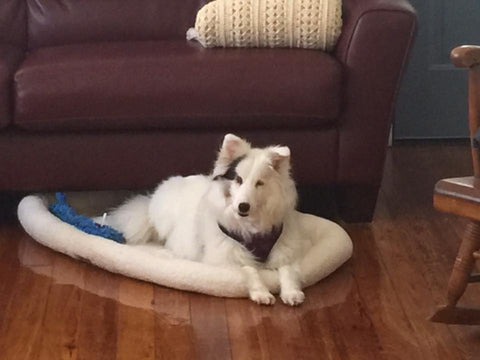Lessons Learned From a Blind & Deaf Dog
Lessons Learned From a Blind & Deaf Dog
It was a late summer evening when I received the call from “The Noah Project,” a local animal shelter where I served as a volunteer and board member. The manager had just completed an intake of a double blue merle sheltie, and she was in rough shape. The police found her tied to a fence, emaciated and flea-infested to the point that her white coat was all black. The manager knew that if this dog was to have any chance of survival, she needed to be fostered outside of the shelter. I couldn’t say no.
For those who don’t know, a double blue merle is a genetic nightmare caused by breeding two merle shelties together. This irresponsible breeding has a very high incidence of deafness, blindness or both. Unfortunately for this dog, she had both.
When I arrived at the shelter, she had been fed, bathed and tested for heartworms. Although she was visibly scared, she was not aggressive toward people or other animals. She carried herself with pride, leading the shelter team to give her the name, Dutchess. With an arm full of special food and flea medication, I loaded Dutchess into my car and took her home. At the time, neither of us realized it would be her forever home.
A New Beginning for Dutchess
The whole family was awaiting our arrival, including my two dogs and two cats. Once everyone finished sniffing each other, my husband put Dutchess on a leash and walked her around our fenced-in yard. When she got comfortable, we took her off the leash and let our other dogs out. We watched in amazement as Dutchess became one of the pack. Our other dogs led her around, as if they knew she was handicapped and needed assurance. When we called the dogs in, Dutchess followed them as they marched single file back into the house. The three had found their pecking order, but more importantly, Dutchess had found her family.

We made Dutchess a bed in our large laundry room, where she could enjoy a little privacy. We showed her where the food and water were, and although she was blind, we always left a nightlight on for her. As the other dogs crowded the laundry room, we realized Dutchess was a popular girl. We decided to move her bed into the family room with the others, but gave her a cage so she could feel protected and safe. It didn’t take long for Dutchess to learn the lay of the land. It was as if she had been part of our family from the day she was born.
Discovering America’s Next Pop Star
My husband and I own a funeral home. One of our dogs, Ernie, was our funeral home’s therapy dog and he went to work with us every day. In those early days, I was afraid to leave Dutchess home alone, so I brought her to work with me. That’s when I discovered that Dutchess loved car rides—so much that her internal block was built around them. She knew when it was time to go to work and would prance around the house, barking with excitement until she was in the car.
It was only when we got into the car that we noticed her true passion: singing. It was like clockwork. As soon as the car turned out of the subdivision, Dutchess would sit up straight on the backseat floor, thrust her head up high and begin her set. This would go on for about 10 minutes, then she would end with a bark before settling down for the rest of the ride. Often, I would catch myself asking her to be quiet, only to realize she couldn’t hear me.
The general public didn’t know about her condition, so she wore a purple saddle that read, “Blind & Deaf.” But Dutchess had no idea she was handicapped, either. These were the cards she was dealt and it was all she knew. She taught us that she didn’t need special treatment, only special accommodations.
Saying Goodbye
Dutchess had been a part of our family for 12 years when it became time for her to cross the rainbow bridge. She had developed canine dementia and would get lost in the house, forget to eat and sleep more than she played. When we found her trembling in a corner and pacing in circles, we knew it was time. She was ready, but we were not. Still, we knew it was the right thing to do.

Rather than remove her from the safety of our home, we chose to have an in-home euthanasia. One Friday evening, our vet came over to help Dutchess cross over to the other side. She laid in my lap, surrounded by the other dogs and cats. As she eased into a deep slumber, I said my final goodbyes to her.
I am forever grateful that Dutchess came into my life on that late summer evening. In fact, my experience with her has led me to seek out more disabled and handicapped pets. These animals have so much love to give. All they need is a little patience and compassion. After all, who doesn’t?
About the Author
Jodi M. Clock is an international speaker and expert on helping families have difficult conversations with their loved ones about legacy planning. After personally witnessing the financial confusion that families endure, especially at an emotionally taxing time, Ms. Clock has centered her career on helping people understand the options available to them. Since 1988, Jodi has worked in the “end-of-life planning” industry, including family and corporate-owned funeral homes, advance funeral planning companies and casket manufacturers. Today, she practices what she preaches at Clock Funeral Home and Clock Timeless Pets with her husband, Dale.







